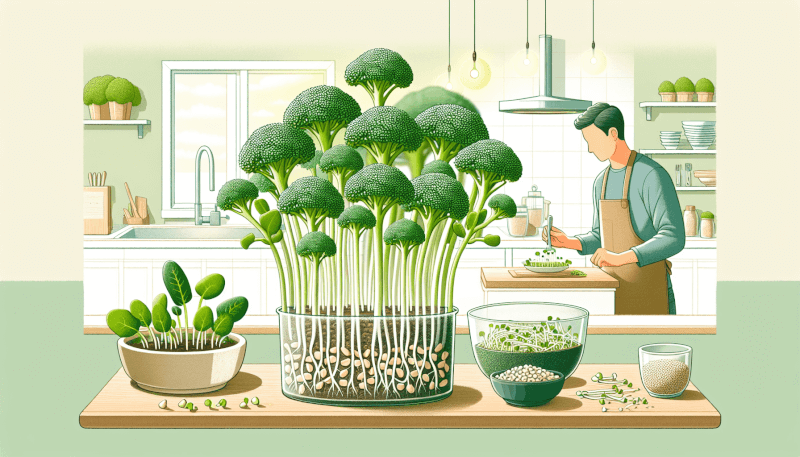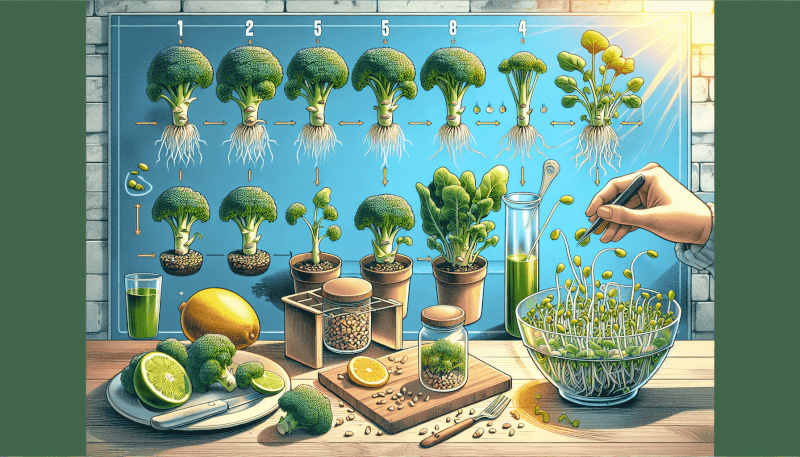👋 Click the mic button to talk to Alfred, the Todd's Seeds Gardening/Sprouting Expert – Feel free to ask him anything!
Ask Virtual Todd Anything - Click the Mic
Broccoli sprouts are becoming increasingly popular due to their numerous health benefits. In this article, you will discover a simple step-by-step guide on how to grow broccoli sprouts and uncover the incredible advantages they bring. From their high nutritional value to their potential cancer-fighting properties, growing broccoli sprouts at home not only provides you with a fun gardening project but also offers a delicious and nutritious addition to your meals. Read on to learn more about the exciting benefits of growing your own broccoli sprouts!
Choosing the Right Seeds
When it comes to growing your own broccoli sprouts, selecting the right seeds is paramount. Opting for organic broccoli seeds ensures that you are starting with a healthy and chemical-free foundation. These seeds are free from pesticides and genetically modified organisms (GMOs), making them a safe choice for sprouting at home.
In addition to choosing organic seeds, it is important to determine the variety of sprouting broccoli you prefer. There are several different types available, each with its own unique flavor profile. Some popular varieties include Green Sprouting, Purple Sprouting, and Di Cicco. Consider your personal preferences and culinary uses when selecting the sprouting variety that appeals to you.
Furthermore, checking for high germination rates is crucial for successful sprouting. Ensure that the seeds you choose have been tested for germination rates and have a high percentage of success. This information is often listed on the seed packet or available from reputable suppliers. By selecting seeds with high germination rates, you increase the likelihood of a successful sprouting process.
Preparing the Sprouting Tray
Once you have chosen the perfect seeds, it’s time to prepare the sprouting tray. Before proceeding, ensure that the tray you are using is clean and sterilized. This is important to prevent any potential contamination that could hinder the sprouting process. Thoroughly wash the tray with warm, soapy water, and rinse it well before sterilizing it with a solution of one part vinegar to nine parts water. Rinse the tray again and allow it to air dry completely.
Creating drainage holes in the sprouting tray is another essential step. Drainage holes allow excess water to escape and prevent the seeds from becoming waterlogged, which can lead to rot. Use a small drill or a sharp knife to create evenly spaced holes in the bottom of the tray. The size of the holes should be small enough to prevent the seeds from falling through but large enough to allow adequate drainage.
To further facilitate drainage, line the tray with paper towels. This helps to absorb excess moisture and prevents the seeds from sitting in a pool of water. Simply place a layer of paper towels at the bottom of the tray, ensuring the entire surface is covered.

Soaking the Seeds
With the sprouting tray prepared, it’s time to soak the seeds. Measure the appropriate amount of seeds according to your desired yield and the size of your sprouting tray. A general guideline is to use approximately two tablespoons of seeds per quart-sized tray.
Before soaking, give the seeds a thorough rinse under cold running water. This helps to remove any dust or debris that may be present. Once rinsed, transfer the seeds to the sprouting tray and spread them out evenly.
Next, submerge the seeds in water and allow them to soak for a specific period. The soaking time can vary depending on the variety of broccoli sprouts you are growing, but a common timeframe is 8 to 12 hours. Ensure that the seeds are fully submerged during this period to promote even hydration.
The Sprouting Process
Once the seeds have been soaked, the sprouting process begins. This crucial phase requires attention and proper care to ensure optimal sprout growth.
To start, drain the water from the sprouting tray and rinse the seeds with fresh water. This helps to remove any residual debris or impurities. Repeat this process twice daily, ideally in the morning and evening, to maintain cleanliness and prevent any potential mold formation.
Throughout the sprouting process, it is important to ensure the right temperature and moisture levels. Broccoli sprouts thrive in a cool and humid environment. Aim for a temperature range of 60 to 70 degrees Fahrenheit (15 to 21 degrees Celsius) and maintain a consistently high humidity level. You can achieve this by covering the sprouting tray with a breathable cloth or lid. Regularly monitor the moisture levels and adjust as needed to prevent the seeds from drying out or becoming too saturated.
As the sprouts start to grow, continue to monitor their progress and make necessary adjustments. If the sprouts become overcrowded, thin them out to allow for proper air circulation and prevent mold growth. Additionally, ensure they are receiving adequate light but not direct sunlight, as this can cause the sprouts to wilt or turn yellow.

Harvesting the Sprouts
After dedicating time and care to the sprouting process, it’s time to reap the rewards of your efforts and harvest the sprouts. Wait until the sprouts reach the desired length, typically around 2 to 3 inches. At this stage, they should have a vibrant green color and tender leaves.
To harvest the sprouts, carefully cut them just above the roots using clean scissors or a sharp knife. Be sure to leave a small portion of the stem intact to promote regrowth for subsequent harvests. After harvesting, rinse the sprouts thoroughly under cold running water to remove any residual dirt or debris.
Health Benefits of Broccoli Sprouts
Now that you have successfully grown your own broccoli sprouts, you can enjoy their numerous health benefits. These sprouts are packed with nutrients and offer a range of advantages for overall well-being.
Broccoli sprouts are high in antioxidants, particularly sulforaphane. This compound has been extensively studied for its potential anti-cancer properties and ability to support the body’s natural detoxification processes. Consuming broccoli sprouts regularly can contribute to reducing the risk of chronic diseases and promoting overall health.
In addition to their cancer-fighting potential, broccoli sprouts can help improve digestion and promote gut health. They are rich in dietary fiber, which supports healthy digestion and bowel regularity. Furthermore, the antioxidants present in broccoli sprouts help reduce inflammation in the gastrointestinal tract, supporting a healthy gut environment.
Nutritional Value of Broccoli Sprouts
Aside from their health benefits, broccoli sprouts are also a nutritional powerhouse. These tiny greens pack a punch when it comes to essential vitamins and minerals.
Broccoli sprouts are a rich source of vitamins C, K, and A. Vitamin C supports immune function and collagen synthesis, while vitamin K contributes to blood clotting and bone health. Vitamin A promotes healthy vision and skin.
Additionally, broccoli sprouts contain essential minerals such as potassium and iron. Potassium plays a vital role in maintaining healthy blood pressure and heart function, while iron is necessary for the production of red blood cells and oxygen transport throughout the body.
Notably, broccoli sprouts are low in calories and high in fiber. This makes them a great addition to a balanced diet, as they provide satiety while being low in energy density, which can support weight management and overall health.
Versatile Culinary Uses
One of the best things about broccoli sprouts is their versatility in the kitchen. These nutritious greens can be incorporated into a variety of dishes, adding a fresh and flavorful touch.
One popular way to enjoy broccoli sprouts is by adding them to salads, sandwiches, and wraps. Their crispy texture and slightly peppery flavor complement a range of ingredients, adding a nutritional boost to your meals.
Another option is to blend broccoli sprouts into smoothies and juices. Their mild taste blends seamlessly with fruits and vegetables, providing an added nutritional punch without overpowering the flavors of other ingredients.
Incorporating broccoli sprouts into stir-fries and omelettes is another fantastic culinary choice. Simply toss them in towards the end of the cooking process to preserve their crunch and nutrients. Their vibrant green color adds visual appeal and a nutritional boost to your savory dishes.
Storage and Shelf Life
To maximize the freshness of your harvested broccoli sprouts, it is important to store them properly. Keeping the sprouts refrigerated helps maintain their crispness and prolongs their shelf life.
Store the harvested sprouts in a sealed container or a plastic bag with any excess moisture removed. This prevents them from becoming soggy or developing mold. Place the container or bag in the refrigerator, ideally in the crisper drawer, where the temperature and humidity levels are optimal for preserving freshness.
While the exact storage time may vary depending on the freshness at the time of harvesting, broccoli sprouts can generally be kept refrigerated for up to five days. However, do note that their quality and flavor may decline over time, so it’s best to consume them as soon as possible after harvesting for the freshest experience.
It is important to note that if your sprouts turn yellow or emit an unpleasant odor, they should not be consumed. These are signs of spoilage and indicate that the sprouts have gone bad. Always prioritize safety and discard any sprouts that do not appear to be fresh and healthy.
Precautions and Safety Measures
While growing and consuming broccoli sprouts can be a rewarding experience, it is important to take certain precautions to ensure safety.
Before handling sprouts or any utensils involved in the sprouting process, make sure your hands and tools are thoroughly washed. This helps prevent any potential contamination and maintains cleanliness throughout the process.
If you are allergic to cruciferous vegetables such as broccoli, exercise caution when consuming broccoli sprouts. Allergies can vary in severity, so it is important to consult with a healthcare professional if you suspect any adverse reactions.
Additionally, when feeding sprouts to infants or pregnant women, be cautious and consult with a healthcare professional. While broccoli sprouts offer numerous health benefits, it is important to consider individual dietary needs and any potential risks associated with specific populations.
In conclusion, growing your own broccoli sprouts is a rewarding and health-conscious endeavor. By choosing the right seeds, preparing the sprouting tray, soaking the seeds, and carefully monitoring the sprouting process, you can enjoy the numerous health benefits and versatile culinary uses of these nutrient-dense greens. Remember to store them properly, prioritize safety measures, and savor the experience of growing your own fresh and flavorful broccoli sprouts.